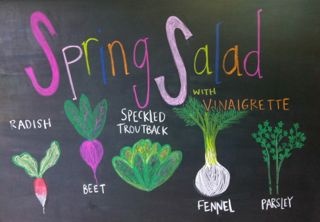Kitchen Humanities: Spring Salad

Summary
In this 6th grade humanities lesson, students prepare a Spring Salad with Basic Salad Dressing and vegetables harvested from the garden.
Objectives
After this lesson, students will be able to:
- Read and follow the recipe, and understand that some recipes are flexible and some are specific
- Taste ingredients and discuss sensory observations using descriptive vocabulary
- Begin to connect the kitchen with the garden and the environment as a whole
Assessments
During this lesson, students will:
- Combine vinegars and herbs to make a customized salad dressing
- Taste the assorted vinegars and discuss similarities and differences
- Identify vegetables grown in the garden and recognize the different plant parts that are edible
Materials
For the Chef Meeting
- Basic Salad Dressing recipe
- Ingredients and tools for demonstration
- Visual aid
Ingredients
For the Salad
Seasonal vegetables, such as:
- Lettuces
- Radishes
- Beets
- Fennel
- Carrots
- Celery
- Snap Peas
- Asparagus
For the Salad Dressing
- Assorted vinegars (red wine, apple cider, rice, balsamic, champagne)
- Olive oil
- Salt
- Pepper
- Garlic
- Assorted fresh herbs (optional)
- Mustard (optional)
- Shallots (optional)
- Honey (optional)
Tools
- Salad spinner
- Salad bowl
- Vegetable peelers
- Whisk
- Chef knives
- Paring knives
- Wavy knives
- Cutting boards
- Measuring beaker
- Measuring spoons
- Dropper bottles (for tasting vinegars)
Before You Begin
- Harvest or purchase the vegetables
- Collect all the tools and ingredients, and then distribute them to the tables
- Gather supplies for the Chef Meeting
- Create the visual aid
- Copy the Basic Salad Dressing recipe to hand out
- Set out the vinegars for tasting
Procedures
At the Chef Meeting
- Welcome students and introduce spring salad as an opportunity to eat food harvested straight from our garden.
- Review the seed to table cycle. Choose one ingredient harvested from the garden and trace its steps through propagation, transplanting, and harvesting.
- Review the different vegetables we will be eating in the salad, emphasizing the different plant parts (leaf, root, bulb, flower, fruit, stalk) that will be used.
- Discuss the difference between a recipe that is precise and a recipe that is flexible. Encourage students to taste the different vinegars, paying attention to the different flavors of each.
- Explain the process of emulsifying by gradually whisking the olive oil into the vinegar.
- Ask students to wash their hands and join their table group.
At the Table
- Meet with the table groups to review the recipe, the vegetables on the platter, and how each vegetable will be prepared.
- Check-in and assign cooking jobs.
- Prepare the recipe and set the table.
- Eat.
- Clean up.
At the Closing Circle
Have the students identify a kitchen technique they used while preparing the salad.
Vocabulary
Emulsify